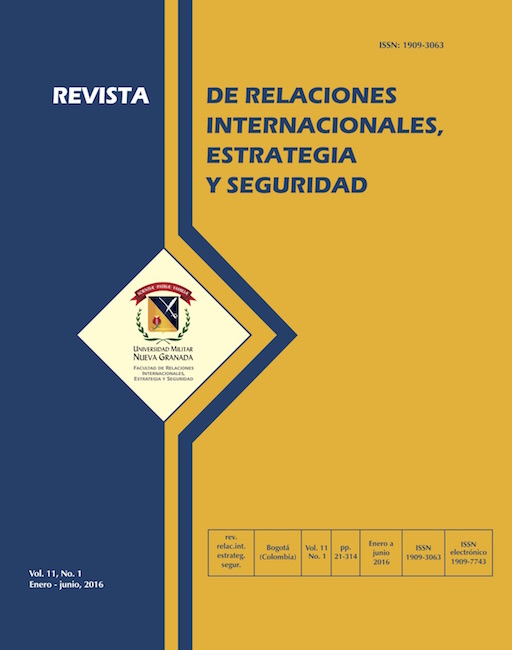Europa ante la amenaza del radicalismo religioso del Estado Islámico
Resumen
El objetivo principal del presente artículo es presentar un análisis crítico acerca de cómo la emergencia y el auge del Estado Islámico, su proclamación de un nuevo califato y su radicalismo religioso violento representan una grave amenaza para la seguridad internacional, especialmente en Europa. En la actualidad, el Estado Islámico se ha convertido en la organización yihadista más notoria. Su expansión territorial, su ideología extremista, su capacidad operacional y su estrategia de reclutamiento de combatientes extranjeros hacen de esta organización una gran amenaza para el continente europeo, debido a su proximidad geográfica y a su influencia tradicional en Medio Oriente, y al aislamiento y la marginalización infligidos a gran parte de la población musulmana en la región. Europa se enfrenta a un escenario complejo en el cual el extremismo religioso podría generar violencia y actos de terrorismo. Es por esta razón que las sociedades europeas liberales deben llegar a un entendimiento acerca de cómo lidiar con esta amenaza en concreto.Descargas
Lenguajes:
esReferencias bibliográficas
Al Qaeda's Second Fatwa. (1998, febrero 23). PBS Newshour. Recuperado de http://www.pbs.org/newshour/updates/military-jan-june98-fatwa_1998/
Aly, A. (2015). Radicalization processes. Conferencia presentada en el Lowy Institute for International Policy. Sidney.
Amara, M. (1985). Asahwa AlIslamiyya Wa Tahaddi Al-Hadari. Cairo: Dar Al-Mustaqbal Al- Arabi.
Aslan, R. (2010). Introduction. En. Aslan, R. Global Jihadism: A Transnational Social Movement (pp. 1-6). Saarbrücken: VDM Publishing.
Azzam, M. (2007). The Radicalization of Muslim Communities in Europe: Local and Global Dimensions. The Brown Journal of World Affairs, 13(2). 123-134.
Bar, S. (2008). The Religious Sources of Islamic Terrorism. En Negrin, H. & Perry.M. (Ed.). The Theory and Practice of Islamic Terrorism: An Anthology (pp. 11-20). New York: Palgrave Macmillan.
http://dx.doi.org/10.1057/9780230616509_2
Barrett, R. (2014). Foreign Fighters in Syria. Nueva York: Soufan Group.
Berger, J., & Stern, J. (2015). The Rise of ISIS. En Berger, J. & Stern, J. ISIS: The State of Terror. (pp. 33-52). Nueva York: Harper Collins.
Bigo, D.; Bonelli, L.; Guittet, E. & Ragazzi, F. (2014). Preventing and Countering Youth Radicalisation in the EU. Bruselas: Parlamento Europeo.
Bin Laden, O. (1997). Impact: Holy Terror? (P. Arnett, Entrevistador).
Chrisafis, A. (2015, agosto 22). France train attack: Americans overpower gunman on Paris express. The Guardian. Recuperado desde: http://www.theguardian.com/world/2015/aug/21/amsterdam-paris-train-gunman-france
Coughlin, C. (2014). The new jihadists make al-Qaeda look like tired old has-beens. The Telegraph. Recuperado de: http://www.telegraph.co.uk/news/worldnews/middleeast/syria/10636336/The-new-jihadists-make-al-Qaeda-look-like-tired-old-has-beens.html
Consejo de la Unión Europea. (2005a). The European Union Counter-Terrorism Strategy. Bruselas: Parlamento Europeo.
Consejo de la Unión Europea. (2005b). The European Union Strategy for Combating Radicalisation and Recruitment to Terrorism. Bruselas: Parlamento Europeo.
Davis, S. (2014). Responding to Foreign Terrorist Fighters: A Risk-Based Playbook for States and the International Community. Goshen: Global Center on Cooperative Security.
Ganor, B. (2008). The counter-terrorism puzzle: A guide for decision makers. Piscataway: Transaction.
Gendron, A. (2006). Trends in terrorism No. 4 - Militant Jihadism: Radicalization, Conversion, Recruitment. Ottawa: Integrated terrorism Assessment Centre.
Gray, M., & Meilhan, P. (2015, agosto 23). Americans who thwarted train attack praised for 'exceptional courage'. CNN. Recuperado de: http://edition.cnn.com/2015/08/22/europe/france-train-shooting-americans-overpower/
Gunaratna, R. (2003). Inside Al Qaeda: Global network of terror. New York: Berkley Books.
Hashim, A. (2014). From Al-Qaida affiliate to rise of the Islamic Caliphate: The evolution of the Islamic State of Iraq and Syria (ISIS). Singapur: Rajaratnam School of International Studies.
Henman, M. (2014). The Islamic State's European Fighters. Londres: IHS Aerospace, Defense and Security.
Jabbour, N. (1994). Islamic Fundamentalism: Implications for Missions. International Journal of Frontier Missions. 11(2), 81-86.
Joshi, P. (2015). Isis: Fears of British jihadi VJ Day plot to assassinate the Queen. International Business Times. Recuperado de: http://www.ibtimes.co.uk/isis-fears-british-jihadi-vj-dayplot-assassinate-queen-1514686
Khan, L. (2006). Phenomenology of Jihad. En. Khan, L. A Theory of International Terrorism: Understanding Islamic Militancy (pp. 170-205). Leiden: Koninklijke Brill NV. http://dx.doi.org/10.1163/ej.9789004152076.i-375.22
Kirdar, M. (2011). Al-Qaeda in Iraq. Washington: Center for Strategic and International Studies (CSIS).
Kousary, H. (2014). Islamic State: Another Phase in Histoy of Islamist Power Struggle. "Substance" not "form" matters. Kabul: Centre for Conflict and Peace Studies.
Leiken, R. (2005). Europe's Angry Muslims. Foreign Affairs. Recuperado de https://www.foreignaffairs.com/articles/europe/2005-07-01/europes-angry-muslims http://dx.doi.org/10.2307/20034425
Llegan a Bogotá los cuerpos de 2 colombianos muertos en un ataque en Túnez. (2015, marzo 23). BBC. Recuperado de: http://www.bbc.com/mundo/ultimas_noticias/2015/03/150323_ultnot_colombia_llegan_cuerpos_colombianos_muertos_atentado_tunez_lv
Marek, P. (2007). Op-Ed: Why the Peaceful Majority Is Irrelevant. Israel News. Recuperado de: http://www.israelnationalnews.com/Articles/Article.aspx/6996#.VQ8GEfmUfci
McCauley, C., & Moskalenko, S. (2010). Protecting the homeland from international and domestic terrorism threats: Current Multi-Disciplinary Perspectives on Root Causes, the Role of Ideology, and Programs for Counter-radicalization and Disengagement. Recuperado desde http://www.brynmawr.edu/psychology/documents/McCauleyMoskalenko.pdf
Migaux, P. (2007). Al Qaeda. En Arnaud, B. & Chaliand, G. (Ed.), The History of Terrorism: From Antiquity to Al Qaeda. (pp. 314-348). Berkeley: University of California Press.
National Intelligence Council, (2012). Global Trends 2030: Alternative Worlds. Recuperado de https://globaltrends2030.files.wordpress.com/2012/11/global-trends-2030-november2012.pdf
Negrin, H., & Perry, M. (2008). Jihadism: Theology and ideology. En, Negrin, H. & Perry. M. (Ed). The theory and practice of Islamic terrorism: An anthology. (pp. 7-10). Nueva York: Palgrave Macmillan.
Nielsen, N. (2015, enero 12). No plan for EU spy agency after Paris attacks. Euobserver Recuperado de: https://euobserver.com/justice/127175
Onyanga-Omara, J. (2015). Timeline: Terror Attacks in Europe Over the Years. USA Today. Recuperado de: http://www.usatoday.com/story/news/world/2015/01/07/terror-attackseurope/21384069/
Precht, T. (2007). Homegrown Terrorism and Islamist Radicalisation in Europe: From Conversion to Terrorism. Copenhague: Ministerio de Justicia de Dinamarca.
Roy, O. (2007). Islamic Terrorist Radicalisation in Europe. En Amghar, S.; Boubekeur, A. & Emerson, M. (Ed.). European Islam: Challenges for Society and Public Policy. (pp. 52-60). Bruselas: Center for European Policy Studies.
Segalov, M. (2015, julio 21). Briton arrested over Isis terror plot to attack US troops on UK soil. The Independent. Recuperado de: http://www.independent.co.uk/news/uk/home-news/briton-arrested-over-isis-terror-plot-to-attack-us-troops-on-uk-soil-10404727.html
Veldhuis, T. & Staun, J. (2009). Islamist radicalisation: A root cause model. The Hague: Netherlands Institute of International Relations Clingendael.
Vinatier, L. (2014). SANA Dispatches - Foreign Jihadism in Syria: The Islamic State of Iraq and al Sham. Ginebra: Security Assessment in North Africa.
Witney, N. (2015). Europe and the Islamic State: Venturing Down the Wrong Track. En The Islamic State Through the Regional Lens (pp. 97-101). Londres: European Council on Foreign Relations.












